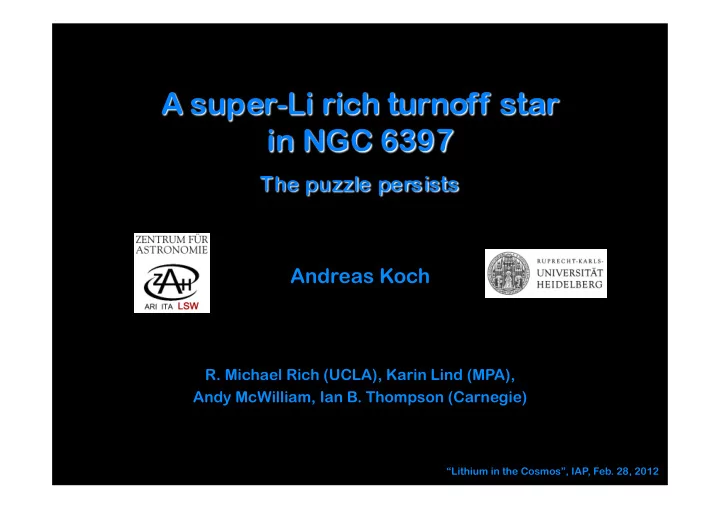

Andreas Koch R. Michael Rich (UCLA), Karin Lind (MPA), Andy McWilliam, Ian B. Thompson (Carnegie) “Lithium in the Cosmos”, IAP, Feb. 28, 2012 !
Plateau is well established (Spite & Spite 1982; Charbonnel et al. 2005) ; depletions from BBN A( 7 Li) = 2.72 (WMAP; Cyburt et al.2008) , albeit persistent puzzles. Over abundances: Li-rich giants (Ruchti et al. 2011) in the MW disk and in GCs (Kraft et al. 1999) : ~1% of RGB are Li- rich (e.g., Kumar et al. 2011) . Very few super-Li rich dwarfs (e.g., Deliyannis et al. 2002).
- 2 nd closest Galactic globular cluster (d o = 2.3 kpc, R GC = 6.0 kpc). - Archetypical, metal-poor ([Fe I / H] = -2.10) halo GC. - Typical GC abundance patterns: - enhanced [ � /Fe]; - Na-O anticorrelation - Na-Li anticorrelation - Trends of [X/H] with T eff due to diffusion (Korn et al. 2007; Nordlander et al. 2012) AK& McWilliam 2011, AJ,142, 63 - MIKE: 3 RGB, 3 TO stars
EW (6707 Å) EW (6103 Å) = 325 mÅ = 65 mÅ A NLTE (Li) = 4.21 ± 0.06 ± 0.14 (AK, Lind, & Rich, ApJL, 738, 29) Lind et al. (2009); Deliyannis et al. (2002); Monaco et al. (2011); Adamów et al. (2012)
1) Ingestion of planetary bodies (Takeda et al. 2001; Ashwell et al. 2005) : + Happens in giants and WDs - No systematic difference of refractory vs. volatile elements - Too metal poor. 2) Type II Supernovae (e.g., Woosley & Weaver 1995): + can produce Li in � -process - No abnormal hydrostatic element abundances 3) Diffusion / rad. acceleration (e.g., Deliyannis et al. 2002; Richer et al. + Can yield such high enhancements 1993) + Can yield such high enhancements - only works in very narrow T-range (6900 – 7100 K) 4) Binary mass transfer: + Is #1657 in a binary?
3) Diffusion / rad. acceleration (e.g., Deliyannis et al. 2002; Richard et al. + Can yield such high enhancements 2005) - only works in very narrow T-range (6900 – 7100 K) Deliyannis et al. (2002); model by Richer et al. (1993)
HST image (Richer et al. 2008; Rich et al. 2011) � v = -120 km s -1 No more than 16% total (continuum) flux contribution. No evidence of velocity variations.
1) Binary transfer from (S-)AGB companion + CF71 (Hot Bottom Burning) was originally conceived for AGBs (Ventura & D'Antona 2011) - No enhancements in s-process elements; - Na is low , not high. First generation star. Ba II 4554
2) Transfer from RGB companion (Sackmann & Boothroyd 1999) + CF71 also works here: cool bottom processing + "standard" abundances (modulo mixing patterns) + efficient in metal poor GCs - very short lived phase (< 4 x 10 4 yr); needs fortunate timing.
Serendipitous discovery of most Li-rich star in a • GC: A NLTE ( 7 Li) = 4.21 ± 0.06 ± 0.14. None of the standard scenarios works satisfyingly: • [X/Fe] is compatible with other stars in NGC 6397. We cannot rule out Li-production in CBP in a former • RGB companion. Why aren’t there more ? •
Future missions will unravel Galactic structures, substructures, and find many (Li-) oddballs: Gaia (2013): radial velocities, PMs Dedicated spectroscopic programs, as (Gaia-) follow- up, and also for themselves (complements): GES (FLAMES/UVES), Jan. 2012 GYES (CFHT; R~20000) MOONS (VLT; R~5000, 20000) 4MOST (NTT, VISTA; R~5000, 20000) WEAVE (WHT; R~20000) ...
Recommend
More recommend